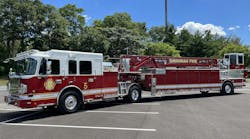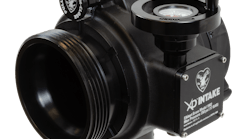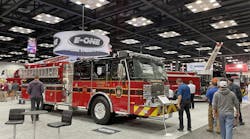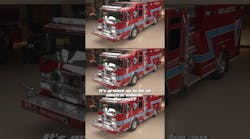What was your last department training session like? What tools did you use? Maybe you started the saw, stretched a line or did some SCBA training. When was the last time your department had a training session devoted strictly for your apparatus drivers? I am not talking about Sunday morning road test or the "we'll let that new driver candidate get behind the wheel for a few minutes on the way to the training site." What I am talking about is a labor-intensive drivers' drill. Like most departments you may have never had a drivers' drill.
Firefighters spend many hours training. A majority of those training hours are spent on hose, ladders and SCBA skills. Meanwhile, we may or may not be called upon to use these skills on our next response. However, we must use our emergency vehicles on every response. Yet, the ratio of training hours to fire apparatus' use is low, and in some departments, almost non-existent. Why is it that the tool we train with the least (emergency vehicles) is the one we use most and the tools and skills we use less frequently, are the ones we spend the majority of the training time on? Does this make any sense? When we receive an alarm, we use our emergency vehicles 100% of the time - whether it be a chief's car, ambulance or fire apparatus. Yet, in many departments, specific training for driving emergency vehicles is almost non-existent. Driving the apparatus to the scene of an emergency is the most important job in the department. If the apparatus does not arrive safely, the chief cannot command, the firefighters cannot fight the fire and the person who called for help cannot be helped. A firefighter I work with told me the story of his first fire apparatus driving experience in his former career department. He was asked before the start of the shift if he could pump and drive the apparatus. He answered yes, and was assigned to drive for that shift. Lucky for that department, he was a good firefighter and had previous emergency driving experience that his department was unaware of. Could this happen in your department? This firefighter was assigned the most important task in the fire service, driving the apparatus, with no formal training.
When we go to any alarm, we may or may not use ladders, hose, SCBA or any other equipment carried on the rig. However, we must always our apparatus to get there. Maybe it is time, with the ever-present threat of large liability awards, and jail that we re-examine the way we drive, train, operate and maintain our fire apparatus.
In the fire service, we constantly talk about safety. Yet very little material, whether it be written, video or slides, are available on emergency vehicle operations compared with most areas of fire protection and suppression. Given that the aforementioned is important, you cannot use any of your knowledge in fire protection or suppression until the emergency vehicle operator delivers the crew and the equipment safely to the scene. The old adage "better to arrive later than planned than not to arrive at all" certainly fits this case. That is why Firehouse.Com's Members Zone now presents this column to promote better, safer, code 3 driving. Do not get the wrong idea that this column is just for emergency vehicle operators. Whether you are a fire chief, municipal officer, legal counsel, fire commissioner, city manager, apparatus driver (whether it be for fire or ambulance) or drive your personal vehicle to alarms, this column should be essential reading for you.
Here are some frequently asked questions I will try to answer for you. As an emergency vehicle operator can I be sued? Can I go to jail? Will my personal auto insurance rates rise if I get into an apparatus accident? As a fire chief or a fire commissioner can I be held personally liable if one of my drivers has an accident? I will also discuss the differences between an accident and a crash.
What about apparatus maintenance and record keeping? Who repairs your apparatus? Is he/she qualified and, if so, by whose standards? What kind of preventative maintenance program does your department have? Does your apparatus have a state inspection sticker on it? Do your drivers have state issued commercial drivers licenses (CDL's) even if they are not mandated by your state? Doesn't it make sense, with the size and weight of present day fire apparatus, that we follow the same rules and regulations as all other commercial vehicles in regards to licensing and inspection?
Let's take a look at both components, the driver and the apparatus. The driver, by virtue of using lights and sirens during a response, is put under a great deal of stress. Most states make the apparatus driver drive with "due regard" for the safety of other users of highway. Simply stated, the apparatus driver has to drive better than everyone else during a code 3 response (lights and sirens). "Due regard" will be covered in a future column. Consider which is more dangerous and difficult to driver - a 3,000 gallon water tanker to an emergency or a 3,000 milk tanker to the market? Obviously, the emergency vehicle driver faces greater challenges. Yet, the milk tanker driver must have a CDL, take a mandatory random drug/alcohol test and does not have to drive with the added responsibility of "due regard" or the added stress of a code 3 response.
Now look at the other component - the vehicle. Commercial vehicles must be inspected, yet only 19 states require fire apparatus to be inspected. Why shouldn't fire truck brakes, springs, steering or other mechanical parts wear out just as fast as other commercial vehicles? Actually, the constant accelerating and braking done in a code 3 response takes a tremendous toll on fire apparatus. One would only have to look at the state of CT where two brother firefighters were killed when the engine's brakes failed as proof of this. This should show how important vehicle inspection and maintenance should be. Shouldn't the fire service start following the same rules and regulations as everybody else? Just because we have done something the wrong way for 60 years, doesn't make it right.
Training, maintenance and legal issues will be covered in-depth in the future. I will also look at such controversial issues as the use and abuse of lights and sirens, response safety and liability and how it affects you. I will explore your rights and obligations under the law. I will show you what to expect in a courtroom if you have had an accident. I will cover response policies: are you exposing too many fire apparatus to the risk of an accident for certain types of alarms? I know of a small city that routinely sends five engines, one ladder truck and one rescue company to alarms received from street pull boxes (mechanical street box). Can you as a fire chief or fire commissioner, justify putting seven pieces of apparatus on the road, with lights and sirens, with the possibility of having an accident for what may prove to be a false alarm?
If you are not yet convinced that more work needs to be done in driver training (in education and accident prevention), take a look at the 2001 NFPA line-of-duty death statistics. We lost 20 brother firefighters last year in apparatus accidents - not from rescuing victims or extinguishing fires. Of all line-of-duty firefighter deaths in 2001, 19% occurred while responding to and returning from alarms. Unfortunately, this is not a new trend. Over the last decade, NFPA reports that it has been typical for 25% of the line-of-duty deaths to have occurred while responding to and returning from alarms. Even though the number of line-of-duty deaths has sharply decreased over the last 10 years(with the exception of the brothers lost at the World Trade Center), the percentage (25%) attributed to responding to and returning from alarms has remained constant over the last decade. At this years present pace Responding and Returning deaths maybe the leading cause of firefighter deaths in 2002. What makes this past 10 years even more tragic is the fact that 28 firefighters died while responding to or returning from false alarms and alarm malfunctions. Can you think of a greater waste of a firefighter's life than to die in a traffic accident? Firefighters are not warriors trained to be expendable. Your worth to your community, fellow firefighters and families is your ability to answer the next alarm, solve the problem and arrive home safely. In plain English, you can't help anyone anymore if you are dead!
Any fire department, paid or volunteer, can take its newest apparatus, put its best driver behind the wheel, the best officer next to the driver and two of its best interior structural firefighters in the cab and have a major accident - killing or seriously injuring the firefighters, totally destroying the department's newest apparatus and preventing arrival to the alarm that they were called to. This is not to mention crashing into innocent citizens that we have taken an oath to protect. No Fire Department is immune.
Don't the risks you take driving (going too fast, running red lights and stop signs and going the wrong way down a one way street) outweigh the benefits gained? When a citizen calls fire dispatch it is because he or she has a problem. We, as firefighters, are dispatched to the location to provide a solution to the problem and render aid. Yet time and time again, we get into apparatus accidents and become part of the problem and not part of the solution.
Here is a case: a small town receives a call for a motor vehicle accident (MVA) at 3:00 A.M., they dispatched one engine, one rescue and one ambulance. One of the responding chiefs' relatives, who's also in the fire department, gets into a car accident responding to the call. Now, the chief has two MVAs to contend with, one involving a relative. The fire department is no longer part of the solution, but part of the problem. Next, the chief redirects his units to respond to his relative's accident and puts a call in for mutual aid for the original MVA. The mutual aid department responds with one engine, one rescue and one ambulance, in addition to all the firefighters driving in their personal vehicles.
We now have twice as many vehicles on the road, in the middle of the night, driving with lights and sirens. We have twice as much risk for another accident, liability claim and loss of firefighters and/or equipment. What about the people in the original MVA that had to wait for a delayed response? Thankfully nobody was seriously hurt. Had that one firefighter (the chief's relative) slowed down and taken extra time to arrive safely, none of the extra manpower or equipment would have been put at risk.
It is my hope that the 21st century is the time in which we seriously address our abysmal driving record and stop getting into accidents. Can we put traditions aside and change response policies and bad driving coupled with a change in attitude? We can drastically reduce the number of line-of-duty deaths and accidents by driving carefully and wearing seat belts. Be a part of the solution and not part of the problem.





